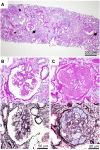Do we have to perform a renal biopsy? Clinical dilemmas in a case with nephrotic syndrome
- PMID: 25125989
- PMCID: PMC4125421
- DOI: 10.4137/CCRep.S16312
Do we have to perform a renal biopsy? Clinical dilemmas in a case with nephrotic syndrome
Abstract
Renal biopsy is one of the pivotal diagnostic tools used in the field of nephrology. A morphological analysis of the kidney may also be of value for the overall management of patients with diabetic nephropathy. However, the indications for renal biopsy differ considerably among nephrologists, and no global consensus regarding performing this procedure among diabetic patients with various renal manifestations has yet been achieved. In this report, we would like to describe our serendipitous experience with a male type 2 diabetic patient presenting with nephrotic syndrome complicated by concurrent gastric carcinoma. We also discuss several conundrums that arose in the current case, which had an impact on our diagnostic and therapeutic decisions.
Keywords: diabetic nephropathy; membranous nephropathy; nephrotic syndrome; paraneoplastic glomerular injury; renal biopsy.
Figures


Similar articles
-
Remission of nephrotic syndrome after surgical intervention for bronchogenic carcinoma: the 10-year follow-up of a patient with membranous nephropathy.Int Med Case Rep J. 2018 Jul 30;11:167-171. doi: 10.2147/IMCRJ.S170267. eCollection 2018. Int Med Case Rep J. 2018. PMID: 30104905 Free PMC article.
-
Indications for renal biopsy in patients with diabetes. Joint position statement of the Italian Society of Nephrology and the Italian Diabetes Society.Nutr Metab Cardiovasc Dis. 2020 Nov 27;30(12):2123-2132. doi: 10.1016/j.numecd.2020.09.013. Epub 2020 Sep 19. Nutr Metab Cardiovasc Dis. 2020. PMID: 33239162 Review.
-
Distribution of glomerular diseases in Taiwan: preliminary report of National Renal Biopsy Registry-publication on behalf of Taiwan Society of Nephrology.BMC Nephrol. 2018 Jan 10;19(1):6. doi: 10.1186/s12882-017-0810-4. BMC Nephrol. 2018. PMID: 29320993 Free PMC article.
-
A Study of Clinical Presentation and Correlative Histopathological Patterns in Renal Parenchymal Disease.Indian J Nephrol. 2018 Jan-Feb;28(1):28-34. doi: 10.4103/ijn.IJN_256_16. Indian J Nephrol. 2018. PMID: 29515298 Free PMC article.
-
[Instructions and implementations for percutaneous renal biopsy. Guidelines for the therapy of glomerular nephropaties].G Ital Nefrol. 2003 Sep-Oct;20 Suppl 24:S3-47. G Ital Nefrol. 2003. PMID: 14666502 Review. Italian.
Cited by
-
Remission of nephrotic syndrome after surgical intervention for bronchogenic carcinoma: the 10-year follow-up of a patient with membranous nephropathy.Int Med Case Rep J. 2018 Jul 30;11:167-171. doi: 10.2147/IMCRJ.S170267. eCollection 2018. Int Med Case Rep J. 2018. PMID: 30104905 Free PMC article.
-
Anti-Neutrophil Cytoplasmic Antibody-Associated Glomerulonephritis and Malignancy: A Case of a Patient Diagnosed with Renal Failure and Pulmonary Carcinoma Concurrently.Clin Med Insights Case Rep. 2021 Mar 28;14:11795476211004604. doi: 10.1177/11795476211004604. eCollection 2021. Clin Med Insights Case Rep. 2021. PMID: 33854397 Free PMC article.
-
An elderly-onset neuroblastoma concomitant with minimal change nephrotic syndrome: the first autopsy case report.CEN Case Rep. 2021 Aug;10(3):414-421. doi: 10.1007/s13730-021-00580-3. Epub 2021 Feb 17. CEN Case Rep. 2021. PMID: 33595829 Free PMC article.
-
Nephrotic Syndrome and a Retroperitoneal Mass: A Case Report of a Patient with Recurrent Invasive Thymoma.Intern Med. 2017 Dec 15;56(24):3317-3322. doi: 10.2169/internalmedicine.9224-17. Epub 2017 Oct 11. Intern Med. 2017. PMID: 29021446 Free PMC article.
References
-
- Jennette JC, Olson JL, Schwartz MM, Silva FG. Primer on the pathologic diagnosis of renal disease. In: Jennete JC, Olson JL, Schwartz MM, Silvia FG, editors. Heptinstall’s Pathology of the Kidney. 6th ed. Philadelphia: Lippincott Williams & Wilkins; 2007. pp. 97–123.
-
- Fuiano G, Mazza G, Comi N, et al. Current indications for renal biopsy: a questionnaire-based survey. Am J Kidney Dis. 2000;35(3):448–57. - PubMed
-
- The Paris endoscopic classification of superficial neoplastic lesions: esophagus, stomach, and colon: November 30 to December 1, 2002. Gastrointest Endosc. 2003;58(6 suppl):S3–43. - PubMed
-
- Akimoto T, Otake T, Tanaka A, et al. Steroid treatment in patients with membranous nephropathy and hepatitis B virus surface antigenemia: a report of two cases. Clin Exp Nephrol. 2011;15(2):289–93. - PubMed
-
- Akimoto T, Ito C, Saito O, et al. Microscopic hematuria and diabetic glomerulosclerosis—clinicopathological analysis of type 2 diabetic patients associated with overt proteinuria. Nephron Clin Pract. 2008;109(3):c119–26. - PubMed
Publication types
LinkOut - more resources
Full Text Sources
Other Literature Sources

